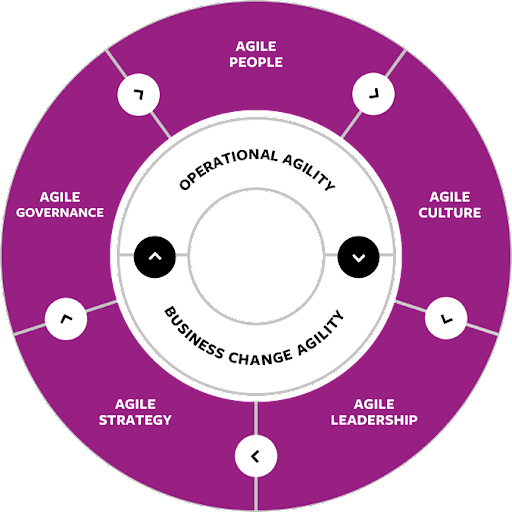Sam Makad
Sam Makad is a business consultant. He helps small & medium enterprises to grow their businesses and overall ROI. You can follow Sam on Twitter, Facebook, and Linkedin.
Navigate the dynamic business landscape with agility. Unlock strategies for innovation and change in this comprehensive handbook for sustainable organizational success.
Business landscapes today are constantly shifting, and as such, agility has become an essential quality that distinguishes successful organizations. To effectively navigate complex market conditions, businesses must be quick to adapt in response to emerging trends, market disruptions, or consumer behavioral shifts.
You can rely on this carefully crafted comprehensive handbook as your go-to source for creating an agile business. Packed with invaluable insight, strategies, and best practices aimed at helping organizations survive in an unpredictable business world, it covers everything from adopting lean methodologies to cultivating an environment conducive to innovation and change.
This handbook serves as an indispensable resource for business leaders seeking to secure the long-term viability of their organizations and achieve sustained success within an ever-evolving, aggressively competitive business landscape.
The corporate world has not merely caught on to a trendy catchphrase with business agility; it's a pivotal concept that has the potential to revolutionize the modus operandi of your organization completely.
Essentially, business agility constitutes a dynamic and adaptive mentality that welcomes change, not as an intrusive disruption but rather as a constant, inevitable companion. It thrives on the spirit of innovation and the capability to react swiftly and efficiently to customers' ever-changing needs and the market's unpredictable dynamics.

This agile mindset boldly challenges the traditional, established business models that might prove inflexible and sluggish to adapt to rapid changes. Instead, it champions flexibility, adaptability, and continuous improvement.
It propagates the idea that businesses should be like the proverbial river, always flowing and ever ready to change course in the face of an obstacle. By internalizing and embracing the principles of business agility, you arm yourself with the necessary tools and mindset to embark on this transformative journey.
You're not just keeping up with the times but learning to dance with the ebb and flow of the business world. These principles will guide you toward becoming a more resilient, adaptable, and ultimately successful business in the face of ever-present change.
A surprising fact is that according to a survey conducted by the Business Agility Institute, approximately 71% of businesses exhibit low levels of business agility.
The journey towards agile transformation is a profound organizational shift that demands meticulous preparation. It's akin to laying the foundation for a resilient and adaptable business structure. This preparation process begins with a deep and holistic assessment of your current business model.
Here, you delve into the intricacies of your existing processes, scrutinize your organizational culture, and gauge the overall readiness of your workforce for the impending changes. In recent years, 81% of organizations have embarked on their agile transformation journey.
One of the pivotal moments in preparing for agile transformation is identifying the compelling need for change. This realization often serves as the spark that ignites the entire transformation process. It's about recognizing that the status quo is no longer sufficient and that staying competitive and responsive in today's rapidly evolving business landscape necessitates a significant shift in how you operate.
This need for change acts as the rallying cry that mobilizes your organization towards agility. Yet, underestimating the challenge of gaining leadership buy-in is not advisable. Leadership commitment is the compass that guides your agile journey.
Without wholehearted support and dedication from critical decision-makers, your agile initiatives may encounter significant resistance and obstacles along the way. Leaders must not merely endorse the transformation; they must become its champions, embodying agile principles and serving as role models for the entire organization.
One often overlooked aspect of business agility is insurance. Adequate insurance coverage can significantly enhance your business's agility by providing a financial safety net in the face of unforeseen events.
Business disruptions, whether due to natural disasters, legal disputes, or unexpected accidents, can pose significant challenges to continuity. Insurance acts as a shield, helping to mitigate potential financial losses and enabling your business to bounce back more quickly.
For example, business property insurance can cover the costs of repairing or replacing damaged assets, such as equipment or office space, allowing you to resume operations swiftly. General liability insurance can protect your business from bodily injury or property damage claims, preventing substantial financial setbacks.
Professional liability insurance is essential for service-oriented businesses, safeguarding against claims of errors or negligence in your services. Furthermore, having insurance can significantly enhance the adaptability and resilience of your business.
The assurance it provides can bolster your confidence and ability to take calculated risks, secure in the knowledge that there is a safety net in place to protect you from potential financial losses. This can be particularly beneficial in promoting a risk-taking mentality, which aligns perfectly with the agile mindset.
In an agile environment, experimentation and innovation are key drivers of growth and success. Therefore, having insurance can foster a more innovative culture within your business, enabling you to experiment with new ideas, take on exciting projects, and explore uncharted territories with greater certainty and less fear.
This can lead to significant advancements and improvements in your business operations, potentially leading to increased profitability and success in the long run.
The practical implementation of agile practices is the nexus where the transformation into a more dynamic and flexible organization truly begins to materialize. Various agile methodologies and frameworks, such as Scrum, Kanban, Lean, and SAFe, embody these practices (Scaled Agile Framework).
Each of these methodologies offers its own unique and structured approaches to instilling agility into the very fabric of your organization. Furthermore, agile planning and road mapping are critical components of this process.
They enable your organization to remain not just responsive but highly adaptive to the ever-changing landscape of market conditions and the constantly evolving demands of your customers. In the realm of project management, agile methodologies empower teams to not only work together efficiently but also to adapt swiftly to shifting priorities.
This adaptability allows them to deliver value to customers in an iterative manner, which is a key tenet of agile philosophy. The practices of continuous integration and continuous delivery (CI/CD) serve to streamline the development and deployment process for products and services.
This approach significantly reduces the time it takes to bring a product to market, further increasing the agility of the organization.

Agile processes never compromise quality, with dedicated testing and quality assurance practices being put in place to guarantee that deliverables always exceed customer expectations. Agile metrics and key performance indicators (KPIs) offer invaluable data-driven insights, helping to monitor transformation progress while making informed decisions.
Together, these components increase agility within an organization, enabling it to thrive in today's fast-paced business world.
Creating an agile business is not merely about the adoption and implementation of new processes; it also necessitates the nurturing of a culture that embraces agility in its entirety. Leadership plays a crucial role in overstating the transformative cultural change.
Leaders must advocate for agility and lead by example, consistently demonstrating an unwavering and steadfast commitment to the principles of agility. Forming collaborative teams that operate seamlessly across various functions and hierarchies is a critical success factor in this endeavor.
These teams must be able to work together effectively, breaking down traditional silos to foster a truly collaborative environment. The establishment of such teams is paramount to the success of an agile business model.
Embracing a 'fail-fast' mentality is equally essential, as it encourages experimentation. This mindset allows for continuous learning from mistakes, thus fostering a culture that is not only receptive to but also driven by innovation.
It is through this process of trial and error and learning from failures that novel ideas and solutions can be born. Transparency and open communication form the bedrock of an agile culture. These principles enable teams to share information, ideas, and feedback freely and without reservations.
In such an environment, every team member is given a voice and feels empowered to contribute meaningfully to the organization's growth and adaptability. This sense of empowerment can lead to increased motivation, creativity, and productivity, further enhancing the organization's agility.
Establishing an agile business is a significant undertaking. It requires a firm commitment, unparalleled dedication, and a process of continuous learning to truly achieve agility in the business field. The corporate sphere should no longer perceive the concept of agility as just another passing trend or a fleeting buzzword.
Instead, consider it an essential and integral part of conducting business in the modern age. To fully grasp the essence of agility, understanding its principles is the first critical step. All other agile practices rest upon the foundation formed by this understanding.
Preparing for transformation is another vital element in the journey towards becoming an agile business. It involves creating a roadmap for change, acknowledging the challenges that lie ahead, and being ready to adapt and evolve in the face of these changes.
Selecting an appropriate agile framework is also a crucial part of this process. It helps structure and guide the transformation, ensuring the transition is smooth and effective. Implementing agile practices in environments that foster an agile culture is the final yet equally important step.
It involves cultivating a mindset that embraces change and encourages innovation, thereby enabling your organization to thrive amidst uncertainty and constant change. Agility isn't simply a methodology or set of strategies; rather, it's a holistic approach that, when adopted by your organization, can create a brighter and more resilient future for itself.
Agility provides your company with the tools necessary for successfully navigating an unpredictable business landscape in the long run, ultimately ensuring its survival and expansion over time.
You’ll also receive some of our best posts today

Sam Makad is a business consultant. He helps small & medium enterprises to grow their businesses and overall ROI. You can follow Sam on Twitter, Facebook, and Linkedin.
Referral programs aren't limited to B2C. Decision makers in...
Business information technology (IT) began with the humble telegraph,...
If you are a content creator, you know that...

User reviews are a game-changer for e-commerce. Consumers rely heavily o...
Don’t miss the new articles!